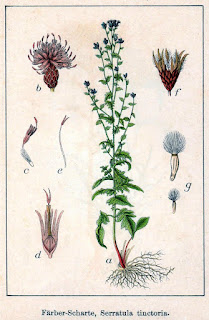 Een miniborder aangelegd met kleurstofplanten. We beginnen klein en breiden uit naargelang we meer planten naar Bretagne kunnen transporteren. De meekrap, gele kamille, wede en zaagblad, die we nu aanplanten, hebben al een lange reis achter de rug. Vanuit mijn tuin in Bellegarde in de Franse Drôme zijn ze via België nu in Bretagne terecht gekomen. Hopelijk kunnen ze hier samen met mij tot rust komen.
Een miniborder aangelegd met kleurstofplanten. We beginnen klein en breiden uit naargelang we meer planten naar Bretagne kunnen transporteren. De meekrap, gele kamille, wede en zaagblad, die we nu aanplanten, hebben al een lange reis achter de rug. Vanuit mijn tuin in Bellegarde in de Franse Drôme zijn ze via België nu in Bretagne terecht gekomen. Hopelijk kunnen ze hier samen met mij tot rust komen.
Over zaagblad dus, is wel een wat trieste naam voor dit familielid van de korenbloem. Het verwijst naar het getand, gezaagd blad. Serratula, Latijn serratus, serra: zaag, de scherp gezaagde bladrand, zaagblad.
Saw-wort (Serratula tinctoria) is an old but not well known dyeplant for yellow. There are written historical evidence of its use since Middle Ages. It was a valued dyeplant in Tuscany, Italy, and used like weld to get yellows and greens with woad to woollen fabrics (Cardon), and actually less of saw-wort than weld was required to get the same shade.
Saw-wort contains the same flavonids as weld, that is luteolin and its glycosides, and apigenin, but also other flavonols. It is considered to give as fast dye as weld. I also found an interesting abstract of a French study of it's flavonoids.
Saw-wort is a perennial plant, and it got my interest right away, because you don't have to sow it every year, only once is enough. You can buy the seeds from Germany from Ruhlemanns.
For dyeing you can use saw-wort from the second year on, so at first it is slow, but once it gets established the crop should be steady.
https://sites.google.com/site/kruidwis/planten-van-a-tot-z/serratula-tinctoria-zaagblad
[Components of Serratula species; screening for ecdysteroid and inorganic constituents of some Serratula plants]

Geen opmerkingen:
Een reactie posten